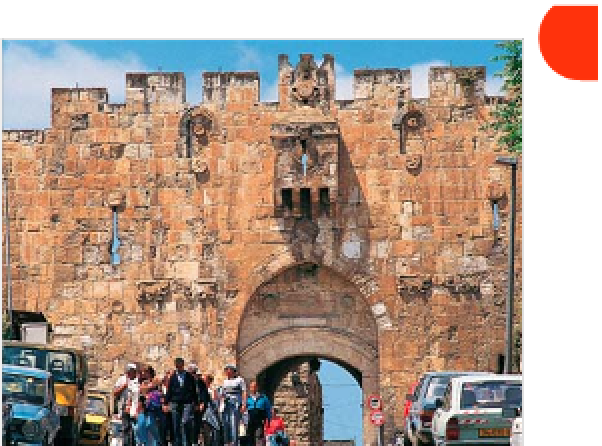Travel Reference
In-Depth Information
the Roman gate, which gives
access to the
Roman Square
Excavations
. Here, the fasci-
nating remains of the original
Roman plaza, the starting
point of the Roman Cardo,
include a gaming board
engraved in the paving stones.
A hologram depicts Hadrian's
A
column in the main plaza. It is
possible to explore the upper
levels of the gate as part of the
ramparts walk
(see pp142-3)
.
Herod's Gate
9
Map
4 D1.
The Arabic and Hebrew names
for this gate, Bab el-Zahra and
Shaar ha-Prakhim respectively,
both mean “Gate of Flowers”,
referring to the rosette above
the arch. It came to be known
as Herod's Gate in the 1500s,
when Christian pilgrims
wrongly thought that the
house inside the gate was the
palace of Herod the Great's
son. It was via the original,
now closed, entrance further
east that the Crusaders entered
the city and conquered it on
15 July 1099
(see pp48-9)
.
The 16th-century St Stephen's Gate, in the Old City's eastern wall
St Stephen's Gate
q
Map
4 F2.
parents of the Virgin Mary,
lived. The supposed remains
of their house are in the
crypt, which is also noted for
its remarkable acoustics.
Shortly after the church was
built, it was made larger by
moving the façade forwards
by several metres. The
connection with the original
church can still be seen in the
first row of columns. In 1192,
Saladin
(see pp48-9)
turned
the church into a Muslim theo-
logical school. There is an
inscription to this effect above
the church's entrance. Later
abandoned, the church fell
into ruins, until the Ottomans
donated it to France in 1856
and it was restored.
Next to the church
are two cisterns that
once lay outside the
city walls. They were
built in the 8th and
3rd centuries BC to
collect rainwater.
Some time later, under Herod
the Great they were turned
into curative baths. Ruins of a
Roman temple, thought to
have been to the god of
medicine, can be
seen here, as can
those of a later
Byzantine church
built over the
temple. It is also
widely believed
that this is the site
of the Pool of
Bethesda, described
in St John's account
of Christ curing a
paralysed man
(John 5: 1-15).
Suleyman the Magnificent
built this gate in 1538.
Its Arabic name, Bab Sitti
Maryam (Gate of the Virgin
Mary), refers to the Tomb of
the Virgin in the nearby Valley
of Jehoshaphat
(see p115)
.
The Hebrew name, Shaar ha-
Arayot, or Lions' Gate, refers
to the two emblematic lions
on either side of the gateway,
although one school of
thought insists that they are
panthers. There are many
different stories to explain the
significance of the lions. One
is that Suleyman the
Magnificent had them
carved in honour of
the Mameluke emir
Baybars and his
successful campaign
to rid the Holy Land
of Crusaders. The
name St Stephen's Gate was
adopted in the Middle Ages
by Christians who believed
that the first Christian martyr,
St Stephen, was executed here.
Prior to that, however, it had
been generally accepted that
St Stephen had been stoned to
death outside Damascus Gate.
The gate is also significant
because of its more recent
history, for it was through it
that the Arab Legion penetrat-
ed the Old City in 1948
(see
p54)
and where Israeli para-
troopers entered in 1967
(see
p54)
. It is an excellent starting
point for the walk along the
Via Dolorosa
(see p64)
.
St Anne's Church
0
2 Shaar ha-Arayot St.
Map
4 E2.
Tel
(02) 628 3285.
#
8am-noon &
2-6pm (winter: 5pm) daily.
&
This beautiful Crusader
church is a superb example of
Romanesque architecture. It
was constructed between
1131 and 1138 to replace a
previous Byzantine church,
and exists today in more or
less its original form. It is
traditionally believed that the
church stands on the spot
where Anne and Joachim, the
Lion detail from
St Stephen's Gate
Archaeological site in front of St Anne's Church











